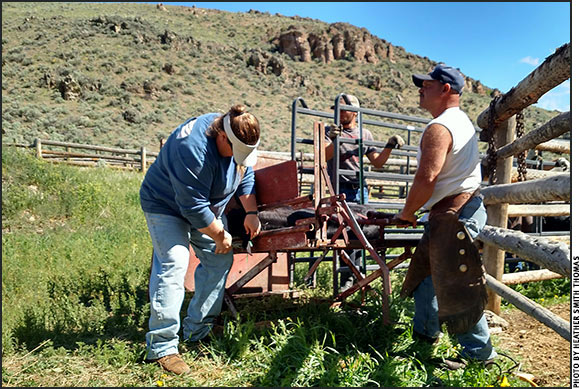HEALTH & NUTRITION...

Vaccinating Calves
Institute a calf vaccination program that supports your situation.
Colostrum provides newborn calves temporary immunity from disease via maternal antibodies. After a few weeks, calves must start building their own immunities. Vaccinating calves at the proper time can help. Vaccinating too soon, however, may not stimulate immune response. If the calf still has maternal antibodies in its system, these may interfere with building its own immunities.
David Smith, veterinarian at Mississippi State University, says many producers simply vaccinate calves at branding or at some point before weaning.
“What most people are doing with calfhood vaccines is to stimulate immunity to protect calves at weaning time.” Read more.
Managing Herd Security, BVD
BVD control, FMD preparedness discussed.
“Bovine viral diarrhea (BVD) is one of the most manageable pathogens affecting cattle producers,” stated Mississippi State University veterinarian David Smith, adding that anyone who wants to avoid BVD in their herd can. “So, if BVD is a manageable disease, why aren’t more producers managing it?”
Smith was among the speakers who talked about infectious disease control during the 2017 Cattle Industry Convention in Nashville, Tenn. Smith shared his views on BVD control during a meeting of the National Cattlemen’s Beef Association (NCBA) Beef Cattle Herd Security/BVD Working Group, where attendees also heard about plans for response, should an outbreak of foot-and-mouth (FMD) disease occur in the United States.
Read more.
Angus Talk
Visiting with K-State’s Gregg Hanzlicek.
Angus Talk host Doug Medlock visited with Gregg Hanzlicek, veterinarian and director of production animal field investigations with the Kansas State University (K-State) Veterinary Diagnostic Laboratory, about the risks of anaplasmosis and what cattle producers should do to protect their herds. Here are some outtakes from their conversation. Read more.
Tip for Winter Grazing Cornstalks
An innovative rancher makes easy work of strip-grazing.
Farmers who grow corn and raise cattle often use cornstalks as winter feed for their cattle. This works best if the corn can be strip-grazed rather than just turning the cows into the whole field — making them utilize most of a certain portion before going into the next segment. Otherwise cattle go through the whole field selecting the ears and most palatable parts of the plants first. Toward the end of the grazing period, they have nothing but the coarser and less nutritious parts of the stalks left. Read more.
Supplementing Body Condition Score
Purina beef cattle nutritionist says supplementation can assist cow and calf health.
“The single hardest time to raise body condition score (BCS) in cows is right after calving,” Ted Perry told his audience at a Learning Lounge session inside the National Cattlemen’s Beef Association (NCBA) Trade Show in Nashville, Tenn., Feb. 3.
Perry, lead nutritionist for Purina’s Beef Technical Solutions division, added that having a cow at a BCS of 5 or 6 before calving is crucial if you want her to breed back. At a BCS of 4, she won’t have the body condition to make it happen. The best time to put weight on her is at weaning, he offered.
He also noted that if cows are at a 7 or 8 on pasture, which they may be on good pasture during the spring and summer, it’s no problem. Read more.
4 Keys for Effective Probiotic Use
Correct choice and use of probiotics is crucial.
The benefits of probiotics keep adding up for livestock producers. Research shows that including probiotics in rations can improve producers’ return-on-investment through better feed efficiency, increased production or even more robust immune responses.
“With benefits like these, feeding a probiotic can easily pay off — but not every probiotic is worth the investment,” says Angel Aguilar, technical service manager for Lallemand Animal Nutrition. “In animals, there are many dynamic and robust bacterial communities that are essential for productivity and well-being. Influencing these communities in a positive way can result in better overall health and productivity. Positive responses we’ve seen in research trials can even lead to reduced treatment costs. Yet, you can’t add just any probiotic to a ration and expect amazing results.”
There are thousands of yeast and bacteria strains, and each can have a different effect — or sometimes no effect at all. To get results, Aguilar suggests using four main criteria for selecting a probiotic. Read more.
Keeping Your Herd STD Free
Avoid a reproductive wreck by keeping costly diseases at bay.
April is Sexually Transmitted Disease (STD) Awareness month, and cattle should not be left out of the conversation. Trichomoniasis, or trich, is a costly STD that can quickly spread during breeding season, reducing your calf crop by more than 50%.
There is currently no approved treatment for trich, and with such a volatile beef market, it’s a disease beef producers can’t afford to ignore. The reasons behind the harsh impact trich has on beef herds is threefold.
- 1. There is a reduced calf crop of up to 50% due to early embryonic loss or abortion.
- 2. Lighter weaning weights result from delayed conception.
- 3. Infected cattle must be culled and replaced, thereby losing the herd’s genetic improvement. Read more.
Cattle Diseases: Common Conditions/Terms
Click here for a list of common conditions and terms related to beef cattle diseases, such as anaplasmosis, brucellosis, BVD, E. coli, IBR and others.
[Click here to go to the top of the page.]






